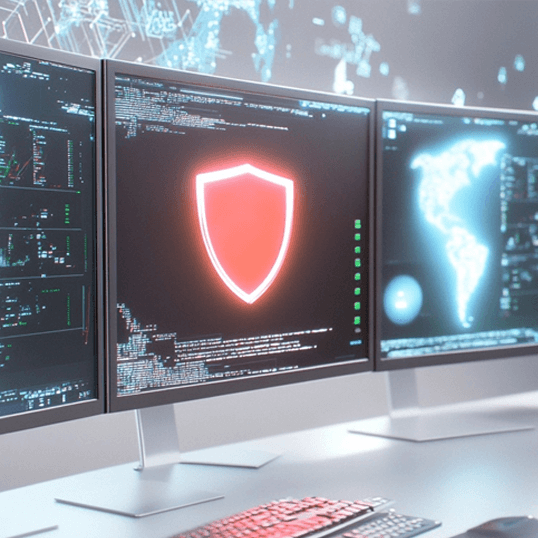Cybersecurity is no longer about waiting for alerts and responding after the fact. In a threat landscape that’s constantly shifting, proactive strategies are essential. This is where Continuous Threat Exposure Management (CTEM) comes into play.
CTEM isn’t just another buzzword—it’s a fundamental shift in how security teams identify, prioritize, and remediate risk. At CyberProof, this concept forms the foundation of our Continuous Threat Exposure Management services, offering organizations a more intelligent and adaptive security posture. Instead of reacting to threats as they emerge, organizations are adopting CTEM to gain ongoing visibility into their entire attack surface, simulate threats in real time, and ensure the most critical exposures are addressed before they can be exploited.
Let’s explore how CTEM is reshaping modern cybersecurity, and why it’s quickly becoming an essential component of mature security programs.
Why Reactive Security No Longer Works
Today’s cyber threats are fast, dynamic, and relentless. Traditional security approaches that rely on detecting known threats or waiting for alerts fall short against adversaries using unknown, evolving tactics. A reactive strategy simply can’t keep up with the pace of modern attacks.
CTEM offers a solution by proactively seeking out exposures before they’re weaponized. It helps organizations detect weak points, simulate attacks, and preemptively secure vulnerable systems—making the leap from response to resilience. As explored in our blog on The Role of Continuous Threat Exposure Management in Cybersecurity, this approach represents a paradigm shift in proactive risk management.
From Point-in-Time to Continuous Visibility
Traditional vulnerability assessments offer snapshots—they show risk at a single moment. But with digital transformation accelerating cloud adoption, remote work, and rapid development cycles, those snapshots are quickly outdated.
Continuous Threat Exposure Management provides a living view of an organization’s vulnerabilities. By combining threat intelligence, asset discovery, and adversarial simulations, CTEM frameworks help security teams:
- Maintain a constantly updated map of their attack surface
- Simulate real-world attacks to validate defenses
- Continuously prioritize exposures based on business risk
This dynamic approach replaces sporadic checks with continuous situational awareness.
CTEM vs. Traditional Vulnerability Management
Unlike traditional vulnerability management tools that often focus on patching known CVEs, CTEM goes a step further. It accounts for all forms of exposure—not just software flaws—including misconfigurations, identity weaknesses, and cloud-specific risks.
Whereas traditional tools ask, “What’s vulnerable?” CTEM asks:
- What matters most to the business?
- How would attackers exploit it?
- Are our controls effective against that scenario?
This shift from technical scoring to contextual prioritization helps security teams focus on what truly matters.
To learn how your organization can assess and strengthen its threat readiness posture using CTEM:
The Key Pillars of a CTEM Program
A successful CTEM program rests on five interconnected pillars:
1. Scoping
Define the assets and environments to be monitored—cloud workloads, endpoints, IoT devices, SaaS platforms, and more. The scope evolves as your business changes.
2. Discovery
Automatically and continuously identify new assets, users, and potential exposures. CTEM tools integrate with cloud platforms and identity systems to ensure nothing is missed.
3. Prioritization
Leverage real-time threat intelligence, asset criticality, and business impact to score exposures. This allows security teams to act on what’s most likely to be exploited.
4. Validation
Simulate attacks using breach and attack simulation (BAS) or red team techniques to verify whether your defenses work in practice—not just on paper.
5. Mobilization
Assign, track, and escalate remediation tasks through automated workflows. Integrate with ITSM tools and measure resolution against SLAs.
How CTEM Improves Risk Management Programs
Security teams are under pressure to show measurable reductions in risk. CTEM helps by:
- Mapping exposures to critical business systems
- Enabling faster detection and resolution
- Providing real-time dashboards to report to leadership
This structured and proactive approach gives executives the insight they need to make informed security investments.
Benefits for Enterprise Security Teams
The adoption of Continuous Threat Exposure Management brings significant benefits across security operations:
- Real-time risk visibility: Know your most critical exposures at all times
- Improved collaboration: Align security and IT teams around clear remediation goals
- Efficient resource allocation: Focus on exposures with real business impact
- Higher resilience: Validate defenses before attackers test them
CTEM also complements other key cybersecurity functions like extended detection and response solutions (XDR), threat hunting, and vulnerability management—extending the discussion we began in What is CTEM? to practical enterprise use cases.—making it an ideal upgrade for security leaders seeking a unified, proactive defense strategy.
Why CTEM Belongs in Your Cybersecurity Roadmap
CTEM isn’t just for large enterprises or highly regulated industries. As cyber risks become more complex and distributed, organizations of all sizes can benefit from integrating CTEM into their strategic roadmap. It’s a practical, scalable way to move from reactive firefighting to proactive security posture management.
The Role of CTEM in Managed Security Services
CTEM has become a cornerstone of advanced managed cyber security services. Providers like CyberProof use Continuous Threat Exposure Management to help clients maintain real-time visibility and reduce risk through continuous validation and simulation. use CTEM to offer clients ongoing, outcome-driven risk reduction.
By embedding CTEM into managed services, organizations can:
- Outsource exposure monitoring without losing visibility
- Benefit from expert threat validation and red teaming
- Accelerate maturity without increasing headcount
How CTEM Supports Cybersecurity Threat Hunting
The best cybersecurity threat hunting programs rely on continuous exposure data to inform where to hunt. CTEM feeds threat hunters with:
- Asset context and behavioral baselines
- Intelligence on high-risk vulnerabilities
- Indicators of compromise (IOCs) from simulations
Instead of broad searches, hunters focus on likely attack paths—making threat detection faster and more effective.
Final Thoughts
Cybersecurity teams are no longer measured by how fast they respond—but by how well they prepare. Continuous Threat Exposure Management offers a strategic way to proactively reduce cyber risk, validate defenses, and align security with business goals.
Whether you’re seeking better visibility, compliance assurance, or threat readiness, CTEM is becoming the new standard for proactive security.
Ready to Transform Your Cybersecurity Program?
Let CyberProof guide your CTEM journey— contact us today to learn how we can help build a more resilient and future-ready security program.** to explore how we can help.
FAQs
What is Continuous Threat Exposure Management (CTEM)?
CTEM is a modern, risk-based cybersecurity methodology that continuously monitors an organization’s digital infrastructure to identify, validate, and prioritize potential exposures. It combines automated asset discovery, continuous monitoring, adversarial simulations, and business risk scoring to proactively manage cyber threats across all environments.
CTEM is a proactive cybersecurity approach that provides ongoing visibility into your organization’s exposures—combining asset discovery, threat intelligence, validation, and automation to continuously reduce risk.
How is CTEM different from vulnerability management?
Unlike traditional vulnerability management that operates on fixed schedules and focuses mainly on patching software weaknesses, CTEM takes a holistic, continuous approach. It incorporates contextual prioritization, validation through real-world simulations, and alignment with business risks. This makes CTEM more dynamic and responsive to emerging threats.
While vulnerability management focuses on patching known software flaws, CTEM covers all types of exposures—including misconfigurations, weak credentials, and cloud risks. It also includes attack simulations to validate defense readiness.
Can CTEM be integrated with existing security tools?
Absolutely. CTEM is designed to complement your existing cybersecurity stack. It integrates with SIEM (Security Information and Event Management), XDR (Extended Detection and Response), SOAR (Security Orchestration, Automation, and Response), CMDBs, vulnerability scanners, and ITSM systems to enrich threat data and streamline response workflows.
Yes. CTEM works alongside SIEM, XDR, and SOAR platforms, as well as asset inventory, identity management, and ticketing systems. It enhances their value by providing continuous exposure insights.
Why should enterprises adopt CTEM now?
Enterprises face growing attack surfaces due to digital transformation, cloud adoption, and hybrid work. Reactive, periodic risk assessments are no longer sufficient. CTEM allows organizations to stay ahead of threats by providing real-time visibility and prioritization. It’s essential for maintaining cyber resilience in today’s volatile threat landscape.
As attack surfaces expand and threats become more sophisticated, point-in-time assessments are no longer enough. CTEM ensures that organizations stay one step ahead by continuously evaluating their security posture.
What types of threats can CTEM help prevent?
CTEM helps identify exposures that could lead to ransomware attacks, phishing exploits, insider threats, and cloud misconfigurations. By proactively validating defenses and simulating attacks, organizations can remediate vulnerabilities before adversaries exploit them.
CTEM identifies misconfigurations, unpatched systems, and weak credentials that attackers exploit. It enables proactive defense against ransomware, phishing, insider threats, and supply chain attacks.
How does CTEM help with compliance and reporting?
CTEM streamlines compliance by continuously aligning exposure management activities with regulatory requirements like NIST 800-53, ISO 27001, PCI-DSS, and HIPAA. It generates audit-ready reports, tracks remediation timelines, and helps demonstrate due diligence to auditors and stakeholders.
CTEM supports regulatory readiness by continuously monitoring controls and generating reports mapped to frameworks like NIST, ISO 27001, and PCI-DSS—streamlining audits and demonstrating due diligence.
Is CTEM suitable for hybrid and multi-cloud environments?
Yes, CTEM is built for complex environments including public cloud, private cloud, on-premises infrastructure, and hybrid models. It connects to various platforms like AWS, Azure, and Google Cloud, ensuring continuous monitoring across all assets and services.
Yes. CTEM is designed for complex infrastructures, including on-premises, cloud-native, and hybrid setups. It integrates with cloud providers, SaaS platforms, and identity tools to ensure full coverage.
How long does it take to see results with CTEM?
Organizations typically start experiencing improved visibility, faster prioritization, and better collaboration within the first 30–60 days of implementation. Over time, CTEM contributes to reduced risk exposure, improved compliance, and more mature cyber operations.
Most organizations begin seeing value within the first 30–60 days through enhanced visibility and faster risk mitigation. Long-term, CTEM supports continuous maturity across the cybersecurity program.













